Knowing how to manage your players’ fitness is one of the keys to becoming successful on FIFA 15 Ultimate Team. We’re here to help you out with this fitness guide.
Quick Access
- Introduction
Definition and Basic Concepts
How it varies
Stamina
Consumables and Staff
How to manage the players’ fitness
New Stuff
FAQ
Introduction to the FUT 15 Fitness Guide
This guide was created to fill the void of lack of information concerning this theme. It is devoted to the less experienced, who will be able to follow some valuable tips that will help them improve their club, but also to the more experienced that might still have a few wrong thoughts.
We will show you what fitness is, its importance in the game and which factors may affect it as well as its variation. We’ll be deconstructing the stamina concept and describing everything concerning this theme, including the fitness coaches cards, fitness training and the slight co-relation there is between injuries and fitness. And more importantly: we’ll list, suggest and explain in detail each of the several methods there are to keep a fresh team. We will cover everything, nothing will go unnoticed.
Fitness – Definition and Basic Concepts
Fitness is an English word that means “being in good shape”. It is directly related to one’s agility, speed, body balance and motor coordination.
In FIFA 15 Ultimate Team, just like its predecessors, the fitness is numerically measured on a scale of 1 to 99. 99 corresponds to a player’s ideal physical condition. It’s the highest fitness possible. 1 corresponds to a critical state you’re not going to want to be familiar with.
There are several ways to visualize a player’s fitness:
Active Squad Screen – RS right or left
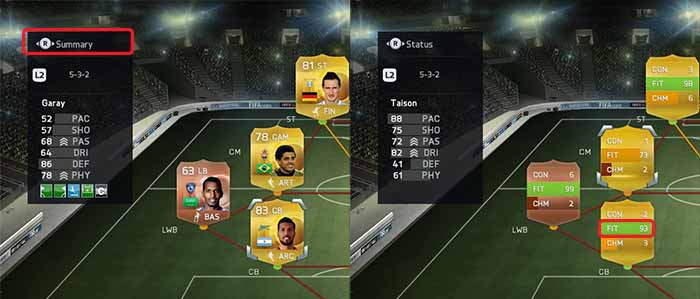
Active Squad Screen – select player – Player Details (RS/R3)
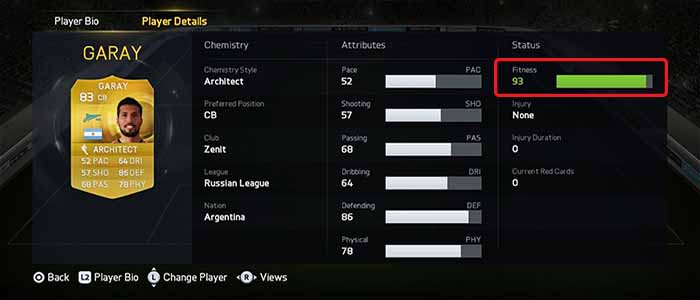
Blue bar above the player name
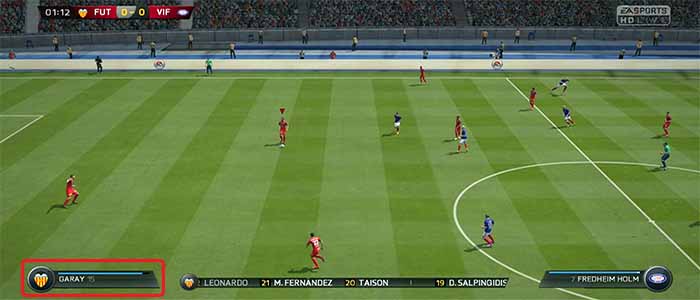
Pause – Green bar above the player name
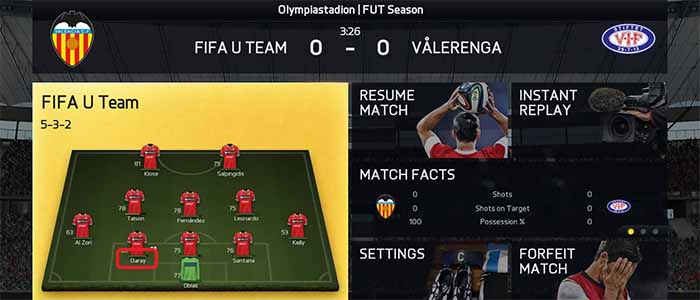
Pause – Team Management – Squad – (Select Player)
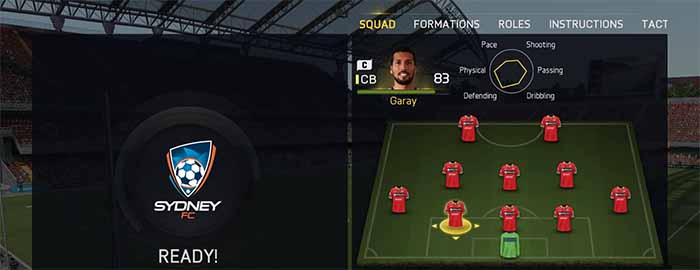
During a match, each player has two fitness bars: the instant bar, represented by a blue bar that goes red in extreme situations; and the accumulated, represented by a white bar overlaid by the blue bar. The first decreases during the sprints, ball disputes or other efforts, and then it regenerates. The second will gradually reduce over a game and serves as a ceiling for the instant fitness bar.
A careful analysis to the following image helps to clarify any questions. The game runs from 1 to 5 and, as you can see, the biggest of the bars is getting smaller. In 1, the bar is almost complete. The only reason to not be completely full is because the player did not start the game with fitness 100. Unlike what happens in 3, in 2 the player is running and therefore is momentarily more tired, ie, less able to continue to make efforts. However, the white bar is bigger which means that with a little rest he will be in better condition than in 3. In 4 he is very close to having to leave the game because he can not make efforts for a long time any more. He gets tired easily. Finally, in 5 the player reached the limit situation. He has to leave or he will get injured.
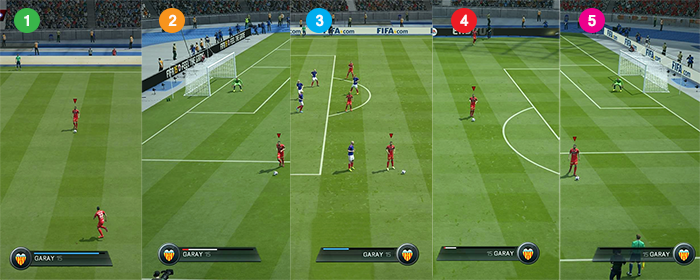
Click in the image to maximize it
A player’s performance on the pitch depends basically on four factors:
- – controller’s and opponent’s skills;
– attributes (including work rate, weak foot and star skills);
– chemistry (individual and the squad’s, in addition to the chemistry style);
– and fitness.
There is a lot of discussion on the first three factors. Players tend to improve their playing skills looking for the best player cards and building squads with maximum chemistry, but not always they give the players’ fitness proper attention. This one is definitely the most ignored but it shouldn’t be. A player with very low fitness will have poor performance. His movements will be slower and obviously he won’t be able to keep up with the team mates and opponents. Besides, he’s more likely to get injured. With defective fitness, Cristiano Ronaldo may look like a bronze player.
How does Fitness vary?
Normally a regular player loses 3 to 5 fitness points per game and a goalkeeper loses 0 to 1
A player’s fitness is improved by rest and moderate physical exercise, and it worsens with too much exercise and potential injuries. That’s what happens both in real life and FUT 15. As the players keep on playing, their fitness level decreases. Resting and specific training can give their ideal fitness back.
The fitness level of a player along a match depends on how much effort he makes. In general, it’s safe to say that it will be higher or lower according to the following factors:
- Playing time
A player’s spent fitness is directly proportional to how long he’s on the pitch. If he plays just for one half, he’ll have spent half the fitness he would’ve spent playing 90 minutes. Obviously this isn’t the only factor since there are types of matches that require more or less effort. You can make a substitution if you feel like sparing some player’s fitness, one you’d like to use on the next match, but if you do that you’ll be spending an extra contract. Also, the substitute will have his fitness decreased by the end of the match.
- Stamina
Stamina is different from player to player. It says to you how fast a player’s fitness deplete. It is easy to understand that players with high stamina lose less fitness during the game than the ones with low stamina. For that reason, they finish the game less tired, ie, with a higher fitness level. If you want to see your players running at the end of the matches as they do in the beginning, you should check that they have a good ‘stamina’ IG stat.
- Effort made
Players get tired as they make effort. This effort rate is measured in FUT 15 by the amount of meters traversed and the intensity and frequency of the body’s work. Players such as goalkeepers tend to move less around the pitch and usually don’t challenge the ball, therefore spend less of their fitness. This way they’re able to keep on playing for much longer than the average player without having their fitness drastically decreased. Anyway, the effort made by a player depends exclusively on who’s controlling. In that case, yourself.
- Injuries
There are two types of injuries: the ones that make players get substituted during the match and those that just lower their fitness. In the second case, it’s up to you. You can keep him on the pitch or not, knowing that he’s not going to be playing at his best. Even if he stays still on the pitch, the moment he gets into a challenge he’ll have his fitness harshly lowered, especially if that’s against a strong defender. You may want to avoid the most aggressive ones. Normally what causes this kind of injury are sliding tackles from behind. When you abuse a player’s fitness making him travel the same exhausting path every time, you’ll be providing him what’s necessary for a muscular injury to happen.
- Work Rate
A player’s work rate, which can’t be altered in FIFA Ultimate Team, affects decisively the amount of fitness points he’s going to lose. It defines the predisposition a player has concerning the different field zones he’s going to occupy. That is how he’s going to behave when you’re not controlling him. It’s independent to the effort made because that one is up to you. Even if you wanted to spare a single player some work, you can’t do anything because the work rate is what determines if he will run or not while he’s not being controlled by you… and you can’t control only one during a match, right?! Players with high work rates, defenders or attackers, are the ones more likely to get tired faster.
In order for you to restore a player’s fitness, you have to put them among the subs or reserves. Players outside of the team, the main 23, cannot restore their fitness condition
Immediately after a game, you can visualize the fitness decrement and increment for each player, even your opponents’, on the Player Ratings menu / Fitness, such as the image below exemplifies. It’s not only possible for you to see how many fitness points each player has lost, but also you’re able to see how many points each substitute eventually restored (lower left corner). The reserves’ physical restoration isn’t indicated in this menu, though. Also, none of this is available when it is a friendly, which by the way doesn’t make sense for us since there is fitness decrease for them as well.
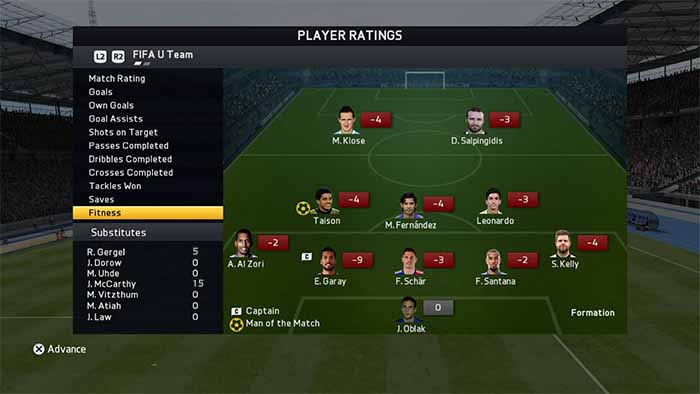
In that case, the keeper finished the game with as many points as he had started
Losing and restoring fitness depends on the type of matches you’re playing
If you put them among the reserves or substitutes, they’ll be able to lose and restore fitness points when it’s one of the following modes in FUT 15:
- Single Player Seasons
Single Player Tournaments
Online Seasons
Online Tournaments
Online Single Match
TOTW Challenge
If you put them among the reserves or substitutes, they’ll be able to lose but not restore fitness points when it’s one of the following modes in FUT 15:
- Online Friendlies
Play a Friend’s Squad
No matter the match mode players can always lose fitness points. Although, fitness restoration is only possible if it’s not a friendly match.
General rule, a field player can lose between 7 and 0 fitness points along the match, although on most cases only 3 to 5 points are lost. ST’s are the ones that lose less points. On the other edge of the field the goalkeepers don’t usually lose more than 2 points, sometimes they don’t even lose a single point.
A player can’t restore more than 35 fitness points in a single match of resting. They cannot have more than fitness 99 even if they apply a fitness card
Resting outside of the 23 selected players for a squad does not allow fitness restoration. If you want a player’s fitness to restore, you’ll have to put him among the substitutes or reserves. It’s the same for both, this kind of fitness restoration is strictly equal. Most of the times, a player that’s not used during a match restores 15 fitness points, except for when the difference between the maximum fitness points (99) and his current value is less than 15, of course. In that case it restores what’s enough to reach 99.
The lower a Player’s Fitness has fallen the longer they’ll have to sit out. The estimated recovery rates are the ones of the following table:
| FITNESS QUALITY | CURRENT FITNESS | RECOVERY RATE |
| Very High | 85 – 100 | +10 |
| High | 70 – 85 | +15 |
| Low | 50-69 | +20 |
| Very Low | 35-49 | +25 |
| Critical | 0-34 | +35 |
TIP
If you want to know how many fitness points a player is going to restore, put him among the substitutes and at the end of the match, before advancing, go to “Player Ratings” – “Fitness”.
Stamina
Stamina is now more important than ever and we will explain why. But this topic requires careful explanation. This is why we created its own chapter.
The stamina measures a player’s fitness variation rating during a match. It measures the tendency a player has to lose fitness points. A player with low stamina tends to get tired fast. By the end of the match he won’t be able to sprint and all his movements will be very slow. On the other hand, players with high work loads should be more resistant, having higher stamina, so that they can actively collaborate on all plays equally, no matter if it’s in the beginning or the end of the match.
A player’s fitness restoration is the same with them being among the substitutes or the reserves
Since a player’s stamina affects his fitness along a match, naturally it also takes part on what will be his remaining fitness level after a match.
Then why it is more important now than in the previous years ? Basically because there was no stamina on FIFA Ultimate Team. In other words, all players got tired in the same speed. It was something that’s been thought out, debated and totally intentional by the developers. This way the game was faster because the players didn’t get tired often during the game. The fact that on the other game modes all players started with 99 fitness but on FUT this didn’t necessarily happen, wasn’t enough to nullify this speed boost.
The absence of stamina in previous FUT’s also allows better explanation for other things often justified by the community with the wrong causes. It’s what happens to the pace abusers, players who base all their strategy on the players’ velocity. These kind of players were very common in Ultimate Team because they just needed to choose the fastest players with maximum fitness and that’s almost always enough to win. They barely got tired and ran all match long like there’s no tomorrow.
Another very common thing in Ultimate Team were the last minute goals. On the other modes, players were often exhausted at this time of the match. Both defenders and attackers. However, the defenders’ job was made easier since they didn’t need to run as much as the opponent’s attackers. In Ultimate Team, the attackers remained fresh therefore had more chance of giving trouble to the opponent’s defenders.
Yes, we know. You are reading this and you are thinking that the game is faster this year. And you are right. But it is not because of the stamina. EA Sports tried to balance the stamina introduction with the speed increase but they clearly failed. EA’s strategy is about the difference of a ‘new’ game: in a single game you have the regular slower modes and then you have a faster option (Ultimate Team).
For many years, the community asked EA Sports to make the game more strategic and less focused on the players’ speed. They could easily have done it, there would be no problem on adding stamina to this game mode without changing the game speed. However, they have decided to keep the game almost as fast as in FUT 13. Maybe because high pace sells more packs than potential high stamina cards.
All this may be new to you, it might bring some doubts, and we’re here to answer them like we always did. The first misconception you might have should be about the fact that the players didn’t get tired along the match. Actually they got tired during the match, always participating challenges for a long period of time or when you constantly pressed LB or L1 hoping to see them run faster. The blue bar gave place to a white one that turned red as you reached its limit. What really happened is that this was just an instant fatigue. A few seconds ere enough for the player to recover all his energy and have maximum fitness once again. Only after several of these pacey plays you would start to get some slight fitness decreases. It was like all players had maximum stamina, like they were so resistant they almost never got tired.
Stamina exist on FIFA 15 Ultimate Team
If you don’t believe in all of this, or if you’re not totally convinced, there’s nothing like a good check for yourself. Start Ultimate Team, pause, go to the substitutions menu, choose any player and take a look at his physical attributes. What stamina does he has there? It’s the same from what’s on the card, isn’t it? It’s different than the one you’ve seen in some database, right? If you look closely, the stamina shown there equals the fitness level he has started the game with. And if you keep checking as the match goes on, you’ll see it doesn’t change. Try even selecting a player that has high work rate and keep sprinting with him all match long. How is he even still running? Fresh as a lettuce, right? Now try to do this on another game mode. See the difference? That’s right, there is no stamina on FIFA Ultimate Team. It’s not something that goes from player to player since it doesn’t have a role at all.
Now do you notice why there was a stamina value for the regular cards when looking at them on databases, but their In Form said something like ‘99’, ‘80’ or ‘-‘? We’ll explain. They all made the mistake of putting stamina values for the regular cards because those attributes came from the other game modes. Actually, this stamina didn’t exist and it would have been better if they didn’t put anything so that there was no confusion. They couldn’t do the same for the In Form because those cards didn’t exist outside of Ultimate Team. The most precise ones said there was no stamina. Others said it was ‘99’ because all players had maximum stamina, which wasn’t a complete lie. The ones that put ‘80’ did that because this was the fitness value for cards that had just been released. Myth unveiled?
Conclusion: in FUT 15 there is stamina, the players get tired easily and you will have to know how to handle with that.
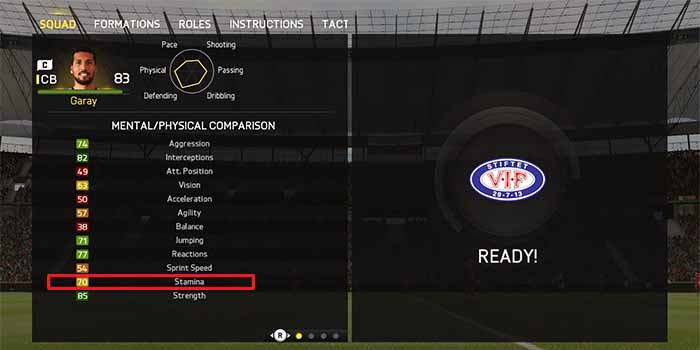
If you want to see the stamina of one of your players, pause a match and follow this path:
Team Management – Squad – Player Details (R3) – Mental / Physical Comparation – Stamina
Consumables and Staff
Like we already said, there are two ways to restore a player’s fitness: you can put him to rest or you can apply fitness consumable cards to have him fresh right on. Even him being injured doesn’t mean you can’t use him, you just need the right physio sessions for his recovery. These ‘improvements’ are made by the application of the following types of cards:
- – Fitness
– Fitness coaches
– Player healing cards
– Physiotherapist cards
Fitness Cards
In order to restore a player’s fitness immediately, you have to apply him a fitness card. There are two types: individual and squad. You can find them on the market or inside packs. As long as the player is not injured, you can apply him unlimited fitness cards.
Fitness cards, which can be gold, silver or bronze levels, increase the fitness shown on a player’s card. If it’s an individual one, it only restores the fitness of one player. If it’s a squad type, it restores the fitness of all 23 players of the squad.
Fitness cards are an expensive way to improve the players’ fitness
When you apply a fitness card on a player, his value can’t surpass 99, even if the current value plus the fitness card value equals more than that. For this reason, we don’t recommend the application of gold fitness cards to your players since they increase too much fitness, at most times they would go to waste. The bronze individual fitness cards increase 10 fitness points and are often enough, especially when having the effect of staff to maximize the result.
Using fitness training cards is the most valid method for fitness restoration but it does require a few coins. In the following chapter you’ll get to know about other more adequate methods to manage your players’ fitness.
If you want to know more about this type of card, click here.
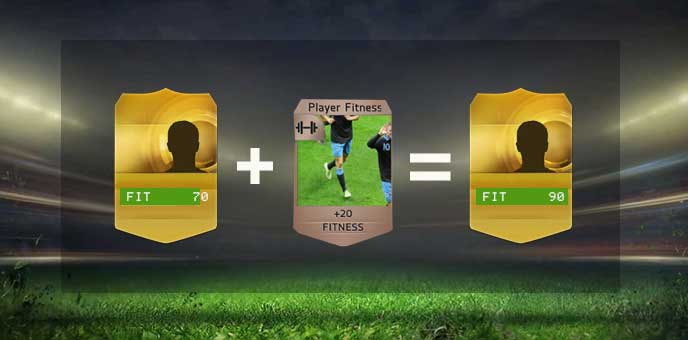
Fitness Coaches
The effect of fitness cards can be maximized if you have a few fitness coaches in your club. They help the players enhance their fitness through a bonus applied on the fitness cards’ final effect.
Fitness coaches, which can be gold, silver, bronze, rare or not, have a percentage written on them that go from 1 to 5%. When you apply a fitness card on a player or a squad, the number of fitness points added receives a bonus for all the fitness coaches’ values you have in your club, which for themselves can’t surpass 50%.
Fitness coaches don’t speed up a player’s natural fitness restoration
If you’re the kind of player that frequently uses fitness cards, it’s really important that you have this type of staff in your club. They’re relatively cheap and don’t require contracts, and still they make your players’ fitness restoration become a much easier process. However, this is their only job. Unlike many people think, having fitness coaches doesn’t influence the players’ natural fitness restoration. While they’re resting between matches nothing different happens, it goes at the same speed as if there were no coaches in the club.
If you want to know more about this type of cards, click here.
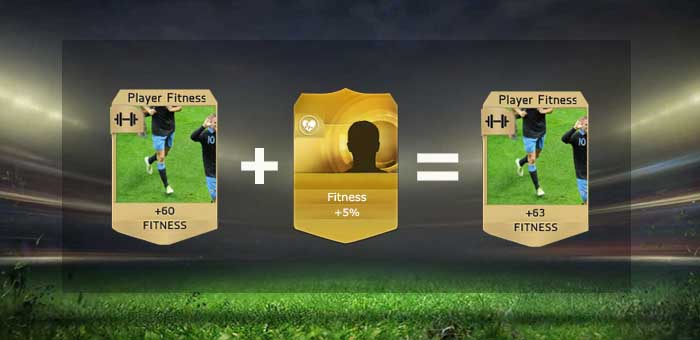
Healing Cards
When a player gets injured, there are two specific information written on his card: the number of matches he will be unable to play and the type of the injury he’s got. If you leave him to rest among the reserves for as long as the period of the injury, he will heal naturally and become available again.
Fitness cards are useless if a player has an injury. In this case, you’ll have to apply a healing card if you want to use this player immediately, or you can at least reduce his healing period.
There are two types of healing cards: the ones that are specific for each type of injury (foot, leg, knee, arm, head, shoulder or back), that can reduce up to 5 matches, and the ones that cure a player no matter which type of injury he’s got, reducing the wait up to 4 matches. When you use one of these cards, the number of matches written on the player’s card is reduced according to its level. If the difference between them is equal to or less than zero, you’ll be able to use the player right on. If the difference is superior, you can keep applying healing cards until you have your player completely healed.
The healing cards, which can be gold, silver or bronze, should only be used if you really need a player in particular that’s got an injury. It’s recommended to avoid direct contact with aggressive players and using players with very low fitness, this is the best way for you to avoid having your players injured.
If you want to know more about this type of cards, click here.
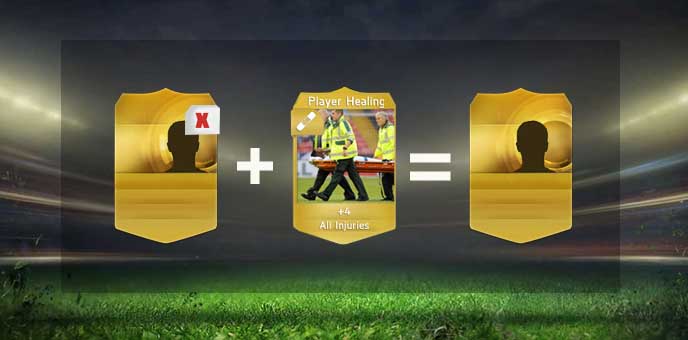
Physiotherapist cards
The effect of healing cards can be maximized if you have a few physiotherapists in your club. They help your players heal from injuries through a bonus applied on the healing cards’ final effect.
Physiotherapist cards, which can be gold, silver, bronze, rare or not, have a percentage written on them that go from 5 to 15%. When you apply a healing card on a player of your squad, the number of matches of rest needed receives a bonus for all the physiotherapists’ values you have in your club, which for themselves can’t surpass 50%.
If you’re the kind of player that frequently uses healing cards, it’s really important that you have this type of staff in your club. They’re relatively cheap and don’t require contracts, and still they make your players’ healing become a much easier process. However, this is their only job. Unlike many people think, having physiotherapists doesn’t influence the players’ natural healing. While they’re resting between matches nothing different happens, it goes at the same speed as if there were no physiotherapists in the club.
If you want to know more about this type of cards, click here.
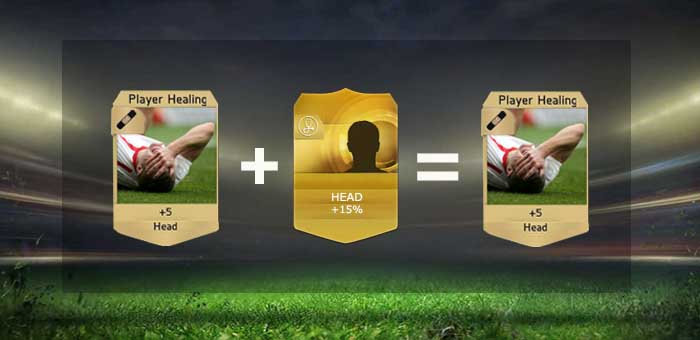
TIP
If you regularly need fitness and healing cards, take advantage of the Happy Hours to buy them with better prices
How to manage your players’ fitness?
Players start losing performance more apparently when their fitness is lower than 90
Knowing how fitness varies is, of course, very important, but on practice what really matters is knowing how you should manage your players’ fitness. They get tired all the time and you’ll have to know how to deal with it. It’s not possible to keep the exact same team playing consecutively without doing anything to restore their fitness, because sooner or later they will get dead tired and start to walk instead of running, and this would surely influence the match results.
Although it is possible to play with low fitness, we recommend that you avoid using players with fitness less than 90 if you don’t want to lose performance.
Let’s analyze all the options you have in order to manage your squad’s fitness properly:
- – Using fitness cards
– Alternating match types
– Using substitutes
– Using an independent team of the same league/nationality
– Using an independent team of another league/nationality
Option 1 – Using fitness cards
Almost every player that has been starting to play Ultimate Team follows one very basic strategy: every time a player finds itself with low fitness you apply him a fitness card. For every two or three matches played you restore his fitness. Although, quickly you’ll realize this isn’t very economically adequate. Even being a fitness bronze card worth around 300 to 400 coins for the whole squad, you’ll have to get one for every two matches since all players don’t lose the same amount of fitness through time, and this will make applying squad fitness cards a more expensive alternative than buying individual cards for those players that get tired first. If you add up this to the contracts you spend, you’ll realize your profit is nullified.
Using fitness cards is easy, quick and extremely simple because it doesn’t require you having a big squad. There will always be the same players. Although this strategy might not be recommended because of its costs, truth is that it’s a good option for certain situations. Like when you’re in the finals of a tournament or are about to play other decisive matches, when there are rewards involved, in these cases they should be seen as a good investment. You might want to get your best players fresh and ready.
Different than what happens with the contract cards, fitness cards are dispensable if you choose another way to manage your players’ fitness.
– The best players are always available
– Easy management
– Doesn’t require a big squad
– Better familiarity with the players
– Economically unsustainable
– Always having the need to buy/apply new fitness cards
– Having fitness coaches in the club is almost mandatory
Option 2 – Alternating match types
If you’ve been reading this guide carefully enough, you may have noticed that when a player rests during a match his fitness is restored, except if it’s a friendly. Then why not use the less important matches as an opportunity to give your main players a rest? This is what many people do. They use their “starting eleven”, the main players, to play in the most important competitions such as on line seasons and tournaments, and as soon as they need some rest, usually after two consecutive matches, they use alternate teams on low difficulty tournaments, like single player ones. In order for this to work, the players that need fitness restoration must be amongst the squad’s substitutes or reserves.
This is a very popular method, especially for people that like to be always using their favourite players. It allows changes that don’t affect the squad’s chemistry, it doesn’t require coins and it’s an easy process overall. The biggest problem is having to interrupt the competition you’re playing in. Most of the time playing these other types of matches isn’t very interesting because you might want to keep playing the competition in sequence. On the other hand, the score can be a disaster because matches with very different difficulties tend to affect our concentration and motivation: easy matches decrease our commitment to the next one while very hard matches lower our confidence. The worst thing is when you lose a match that was supposed to be easy. We get so angry that it definitely affects our performance for the next match and it goes on and on like this. When we’re playing the same competition consecutively this doesn’t happen so often.
– Play the most important matches with your best players
– No spending
– Simple squad management
– Having to interrupt the competition
– Having to play less interesting matches
– Potential concentration and motivation issues
Option 3 – Using substitutes
In real life, the coach uses substitutes and reserves so they can give some of the starting eleven a rest. It’s the same principle for you to manage your squad. For each position you should have a substitute. When the main player gets injured or has low fitness, his substitute is there to cover for him. Once you have eleven on the pitch and 23 on total, there is one left for you to change tactics. According to the tactic you’re using, you may not even need a substitute for each and every player. For example, in a 3-x-x one, having 5 center backs is enough.
One of the difficulties of using substitutes to run a team is about the fact that not all players get tired at the same speed. It means that from match to match there will be players that are supposedly part of the starting eleven going for a rest and eventually going back. Concerning the chemistry , management gets pretty tough. You should be experienced for that. It makes you have a squad based on the same league or nationality, which is not very good for the team’s quality overall. After all there is always the risk of you not having players equally good for each and every position. If you don’t use players of the same league or nationality, it turns out to be a bigger challenge. Building a hybrid team where all players need to have good connections for all combinations possible becomes a true puzzle.
– Using the best players at most times
– No spending
– Always having players to substitute the injured or tired ones
– Extremely hard management
– Possible lack of quality for the second choices
– Less familiar with the team
Option 4 – Using an independent team of the same league/nationality
In alternative for using substitutes to run your squad, you can go on and use an independent group of players. You play normally using your main players and then, as soon as they start to lack fitness, switch them to a whole new group of players of the same league/nationality; use them in a match or two so your main players can restore their fitness. Different than what happens in the previous method, you end up using your favourites less often since you have to give all of them a rest even if only a few need it.
By choosing to build that second team based on the same league or nationality as the starting eleven’s, you’ll be avoiding the risk of having to change the whole team for the next match in case any player gets injured or suspended. Besides, for exceptional cases you’ll be able to choose to restore a player’s fitness in particular by resorting to that second team. On the other hand, you’ll have less options because you’ll be limited only to one league/nationality. For this case as well, the tactic you’re using can make some major influence. For example, good centre backs are found more frequently than good right and left backs, because of that a 3-x-x tactic will ease your squad’s management.
– Relatively easy squad management
– No spending
– Always having substitutes for the injured and tired
– Player choice limited by the chemistry
– Possible lack of quality for the secondary options
– The best players will play less often
Option 5 – Using an independent team of another league/nationality
The last option we give you is nothing more than a variation of the previous. You play using your main team and, when you need to restore a single player’s fitness, switch the whole team to a second team that’s totally independent, but has nothing to do with the main one. Normally this means you’ll be using your main team for about two matches before you have to switch them, but in this case it’s not so bad because you won’t be limited by the chemistry and you’ll be able to build a second team that’s as good as the main one. In other words, you just have to get two or more strong teams and alternate them between the starting eleven and the bench (subs+reserves) according to the players’ fitness. Out of the 23, there’s even one space left able to help a potential injured or suspended player, or an extra one that needs fitness restoration. If you need to change more than one position, there’s no problem on using a substitution during the match for a player that’s resting on the bench, because he’ll get the individual chemistry from the one that started playing.
One of the bad things about this method will be the conditions you might have to follow when you build your teams. Although they’re based on different leagues and nationalities, there can be elements that are common for both teams and you’ll have to choose one, because the same player can’t be in the starting eleven and the bench simultaneously. Building two teams based on two different leagues instead of one league and one nationality won’t be enough to avoid this problem because of transfer seasons, that can happen early on January. They can make one player have two different cards on the same league.
For people that can’t build a second team that’s as good as the main one, it may be mandatory for them to always be spending a few coins on fitness and healing cards due to them not having enough players that can directly substitute the starting eleven.
– Possibility to be always playing at full strength
– Good variety of choices concerning formations for the teams
– Not being able to use duplicates common to both teams
– It may involve some costs
– Few options for punctual changes on the team
Your squad’s fitness condition management shouldn’t only start when one of your players get fitness lower than 90. It should be planned from the beginning of your team building process. This is why it is important that you get to see the various methods there are for you to manage your players’ fitness properly. It doesn’t mean one of the methods is necessarily better than the others. You don’t even have to stick to one method. You can use more than one at a time. It depends on your preferences.
In order to ease interpretation and analysis, the following board shows you the advantages and disadvantages of each method:
| METHOD | 1 | 2 | 3 | 4 | 5 |
| Always being able to use the best players | + | □ | □ | – | + |
| Cost | – | + | + | + | □ |
| Easy Management | + | + | – | □ | □ |
| Similar Leveled Alternatives | + | □ | + | + | □ |
| Team Familiarity | + | □ | – | □ | □ |
| Others | □ | – | + | + | + |
+ Good □ Average – Bad
After all the fitness theme is wider than it seemed, isn’t it?
TIP
Switching from starting eleven to substitutes and reserves is quite a bit tiring, especially if you have to do it every two matches. There’s no need for all that work if you just create two squads in which the starting eleven and the bench are reversed. You just have to do it once. Get them ready, advance on the match menu and before searching for an opponent press Y (Xbox) or triangle (Playstation) to select the other squad. It takes no more than 5 seconds.
New Stuff
For experienced Ultimate Team gamers, most of what we have published here isn’t new. In that way, we have created this short chapter to show what has changed with fitness:
FUT 14 >> FUT 15
- Stamina is working now in Ultimate Team mode
Frequently Asked Questions about Consumables – FAQ
Q: How can my players recover their fitness level ?
A: Make them rest in the reserves.
Q: My fitness is also affected in friendlies matches ?
A: Yes. You lose fitness points but your fitness restoration is not possible.
Q: How much the fitness level increases when player is resting ?
A: Usually no more than 15 points per match. However, the recovery rate may be higher if the fitness level of the player was really low.
Q: How much fitness I lose in a single match ?
A: It depends of many factors. Most of the times, a field player lose 3 to 5 points and a goalkeeper not more than a single point.
Q: What’s the difference between fitness and stamina values ?
A: Fitness value is how much fitness a player starts on in-game. Stamina value represents how fast a player’s fitness deplete.
